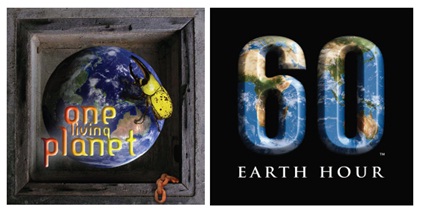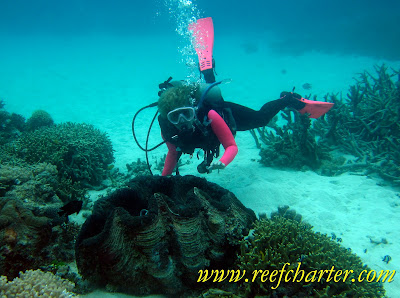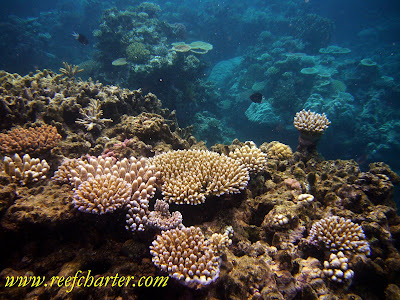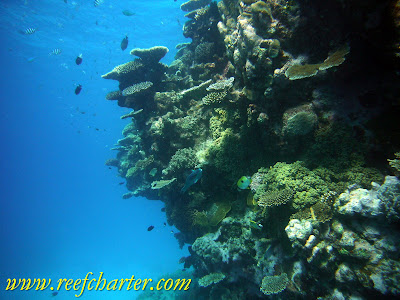We do many things onboard our boats to make sure we minimize our possible environmental impact. That means you can enjoy your diving and snorkeling on the Great Barrier Reef with the knowledge you are not impacting the reef in any detrimental way. One of the things we often talk to our guests about is the use of batteries instead of generators to provide power while we are at the reef.
By capturing energy that would otherwise be wasted during the normal operations of running the engines we charge our extensive battery banks. This allows our snorkelers and scuba divers to enjoy the reef, sunsets and sleep without the noise of a generator in the background. We then recycle the batteries after several years, and eliminating the generator decreases the use of oil and fossil fuels, as well as carbon emissions. A win for both the environment and your travel experience.
So when you are planning your next scuba diving trip to the Great Barrier Reef think about the best way to experience the reef, with only the noise of the waves and birds. If you decide to book with us it’d be our privilege to show you the beauty of this natural wonder…
Tag: Environmental Awareness
A Brief History of the Great Barrier Reef
A lot of our readers have asked for a brief history and background on coral reef formations. I’ll try not to bore everyone. Believe me it makes a better discussion when we are sailing or diving on the reef. The Great Barrier Reef is that like every other ecosystem in world. It’s life-cycle is far greater then man’s living history and we are only just starting to understand this complex underwater world. Most research only dates back 30 years and many data points are close to shore and don’t cover the full extent, depths and variety of coral reefs.
As far as the history of the world goes, reefs appear to be a fairly new phenomenon, only one million years old, a bit older than all of us. The earliest signs of the Great Barrier Reef appeared just over 500,000 years old. Just some background here that a lot of people are unaware of, regardless of what the press etc have been reporting, seas rise and fall naturally and have been doing so since time began. During the rising phase, without human interaction, seas rise about 10m every thousand years. Over the last 500,000 years we have undergone the rise and fall of oceans just under 20 times. The current Great Barrier Reef started growing between 6 and 9,000 years ago, that is when sea levels rose over old underlying reefs and corals started growing. Sleepy yet?
So when the sea level rises the coral reefs take full advantage and often the grow faster then the sea level rises. The coral keeps growing towards the surface, like a plant towards the sun, until the reef flat is exposed at low tides (sea level). When the coral reefs reach the surface, the growth stops or slows and the battle between mother nature and the reef continues. Strong winds, storms, predators, the summer heat, as well as numerous other factors are continually impacting the reef.
So how does the reef survive this continual attack? Well, corals have evolved over thousands of years to survive this delicate ecosystem. So a couple of things:
-When coral spawns it can only successfully seed and grow if the spot it comes to rest on is clean. That means no algae or live coral. So all the damage above actually makes way for the next generation of corals.
– These cycles are natural and the Great Barrier Reef has survived these impacts for hundreds of thousands of years.
– We know from core samples taken around the world that reefs are very resilient to natural events. Only a few species have become extinct over the last 100,000 years.
– Different types of corals grow at different rates so reefs have the ability to reclaim themselves very quickly and then diversify over time as long as there is “seed” coral remaining or another reef nearby.
Coral Reefs build up slowly towards the surface, building upon the growth of previous generations as well as dead coral caused by the impacts above. This is how snorkellers and divers get to enjoy the reefs everyday around the world. By minimizing our impact on the reef we can make sure that this cycle continues.
-Follow reef safe diving and snorkeling practices.
-Reducing major pollutants that have impact on coral growth to ensure that we do not wipe out entire reef systems.
Comparing samples from older reefs to the newer reefs we see that much more damage is happening with much more frequency and to date most reefs have proven resilient. Reefs closer to major human population centres have suffered the most impact. As long as we minimize our impacts, we can be pretty sure that these amazing ecosystems will continue to inspire generations to come.
Earth Hour Video Competition

Earth Hour 2010 – 27 March 8.30 – 9.30pm
What is Earth Hour?
Earth Hour is a worldwide campaign that aims to educate the community about the threats of climate change, informing individuals and businesses about the difference they can make by reducing their emissions at home and in the workplace.Earth Hour started in 2007 in Sydney, Australia when 2.2 million homes and businesses turned their lights off for one hour to make their stand against climate change. Only a year later and Earth Hour had become a global sustainability movement with more than 50 million people across 35 countries participating. Global landmarks such as the, Sydney Harbour Bridge, The CN Tower in Toronto, The Golden Gate Bridge in San Francisco, and Rome’s Colosseum, all stood in darkness, as symbols of hope for a cause that grows more urgent by the hour.
Cairns Regional Council, Ergon Energy, GBRMPA, WWF, WSPLincolne Scott and Hot FM will once again bring Earth Hour to the Cairns Region.
Earth Hour, Every Hour 2010 – “One Living Planet” is the local theme selected by the Earth Hour partnership in Cairns.
The theme for entries must fit under one of the following categories.
What do you think makes life so excellent in FNQ? We have come up with the “Big 5”:
1. keeping our families safe and healthy
2. keeping the rainforest and reef
3. keeping our tropical lifestyle
4. keeping our clean water
5. keeping our culture.
.
The Video Project and How To Get Involved
Earth Hour offers the community the opportunity to express their views on climate change and sustainability – and to get funky and creative in the process.
People of all ages and all levels of experience are encouraged to enter the short film competition. All entries must be accompanied by a completed entry form and adhere to the Conditions of Entry.
An Earth Hour event will be held on 27 March 2010 at City Place featuring family entertainment, public artworks and a screening of selected video competition entries.
What Earth Hour Will Do With Your Entries:
Selected entries will be posted to YouTube and need to comply with YouTube format requirements: QuickTime .MOV, Windows .AVI, or .MPG files—these are the most common formats. YouTube specifically recommends the MPEG4 (Divx, Xvid) format at 640×480 resolution with MP3 audio.
The Prizes
Selected entries will also be screened at the Earth Hour event, and will be in the running for some great prizes from local companies.
They Include:
A new Flip Mini digital Compact Video Camera from the Focus Reef Imagery Centre
2 Double Passes – Cruise for Two and Full Day at Green Island with either a glass bottom boat or snorkel tour with Big Cat Cruises
1 Double Pass— Wilderness Cruise & Crocodile Farm Tour with Crocodile Explorer
1 Double Pass for a Sunset Cruise with Crocodile Explorer
Prize categories include the most creative; best message; funniest; most inspiring.
.
Entries are due: Fri 19th March. Entry forms can be downloaded from:
www.cairns.qld.gov.au or
www.theradio.com.au or directly here
Entry Form – Word Format
For more information contact Annaliese Walker earthhourfnq@gmail.com
How to Run a Good Environmental Program
After the numerous environmental debacles and not much good coming from some recent programs here in Australia (for more info, Solar Panel Risks and Roof Insulation Deaths. I have decided to break my rules and get on my soap box here. We are pretty positive that these theories will apply in most places around the globe. First I need to educate some of the bureaucrats and ministers that exist around the world in some basic business.
Business Profits = (Gross Sales Price) – (Cost of Sales). This may seem obvious to most of us but it seems to be lost to many people we vote for. So how does this tie into environmental programs. Well the businesses installing the green solution and the installer both follow this simple equation to put food on the table for themselves and their employees. Below is a generalization so my apologies to those and some of my personal friends that are doing the right thing. So this means installers will buy readily available materials and sometimes the cheapest. The company or household purchasing the item will also shop for what they deem the most cost effective. We must make the latest most efficient technologies green and affordable.
So let’s get to the meat of what we can do to fix the problems, while creating a better planet and economy.
1. We all know that a snowball does not stand much of a chance in an oven. So let’s stop spending so much money on proving it will melt and work on cooling the oven.
2. Pure research labs come up with concepts that may or may not work they need to engage with engineers and manufacturers to get the product to market. Make funding dependent on that process.
3. Assist manufacturing companies to turn their processing green and to deploy the latest environmental solutions. Fines imposed for not hitting targets are passed onto consumers and the largest companies get the best advantage by being able to hide a smaller amount in more units, even though they maybe the biggest polluters.
4. Publish several key factors; the amount of known environmental pollutants created in the manufacturing process. The amount of pollutants saved per year over conventional products. Letting the public making informed decisions.
5. Have strict standards that ensure only the most efficient products both in their manufacturing process and ongoing savings are eligible for the incentives or rebates.
6. During this whole process the world will need to train and educate everyone from the manufacturers to the installers and consumers on the best use of these products. Include in the incentives guidelines for training and requirements to make sure this process is safe and the most effective.
7. Fund central inspectors and trainers to ensure standards are met and best practices learned and redeployed through the industry. This funding must be included in the original budget for at least the length of the project to ensure compliance and the best outcomes for everyone.
8. Consumer rebates should be consumer rebates, consumers having that control will assist he government with some control. If the consumer isn’t happy they call the government inspector, if he isn’t happy the installer will have to rectify the issue before he gets the rebate amount.
9. Constant reviews of new technologies being deployed with all advisers required to declare publicly any conflicts of interest. Yes, I know, now I have crossed the line. But skeptics are a good part of any scientific process, we need independent scientific reviews and not just hidden associations that are blown out of proportion.
10. Embrace those willing to be the guinea pigs with the new products and allow current regulations to have leeway, understanding that many of the regulations existed before we knew what a solar panel was.
There are lots of things that are not in the above list but it covers the principles of what we are all trying to achieve.
OK, stepping down from the soap box now. This will be the last time, well probably not. Maybe there is an off chance that someone who is a bit smarter with a bit more influence then me may take up this fight.


